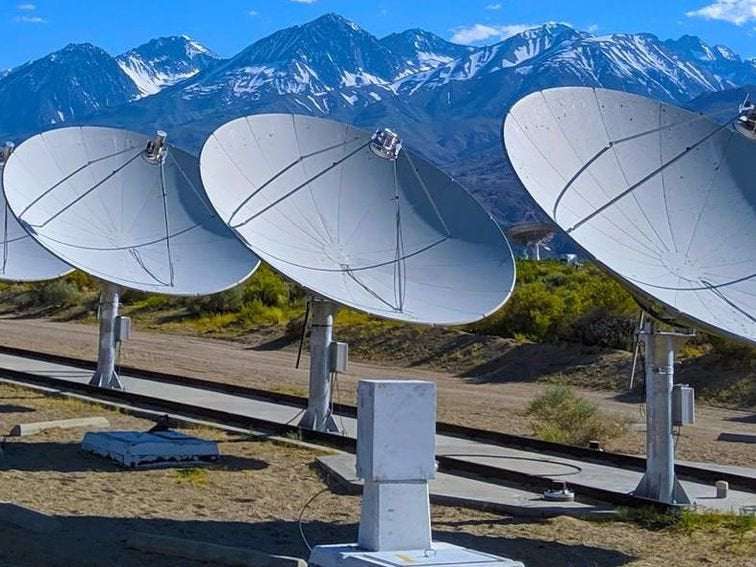Since 2007, astronomers have been finding very brief, powerful signals from across the cosmos in observations gathered by radio telescopes. In the past week, researchers pinpointed the location of a non-repeating signal for the first time, and two days later, another group announced they'd discovered nine more. The sources of these so-called "fast radio bursts" remains a mystery, but recently researchers have been honing their ability to locate their origins.
On Tuesday, a team using CalTech's Owens Valley Radio Observatory near Bishop, California, reported that it managed to capture a new, non-repeating signal dubbed FRB 190523 and trace it back to a galaxy nearly 8 billion light-years away.
A number of possible explanations for what causes FRBs have been proposed, ranging from powerful neutron stars to extraterrestrial intelligence.
An accelerated article preview of the OVRO discovery was published online in the journal Nature, less than a week after an Australian team working with the Australian Square Kilometre Array Pathfinder announced it had also traced a non-repeating burst back to its source galaxy, some 4 billion light-years away.
As if that wasn't enough FRB poppin' off action for a single week, a Russian observatory also reported a batch of nine more FRBs, including a new repeater. Repeating FRBs are kind of a big deal because they're rare (the latest from Russia is just the third ever to be captured) and easier to trace to a source galaxy.
That's a lot of fast radio burst news for just one week, but even still the nature of FRBs remains one of the biggest mysteries in space science. Offering a little more light, the CalTech team traced FRB 190523 back to a galaxy similar to our own Milky Way, but different from the dwarf galaxy that produced the famous first repeating burst, FRB 121102.
"This finding tells us that every galaxy, even a run-of-the-mill galaxy like our Milky Way, can generate an FRB," says CalTech's Vikram Ravi, lead author of the new paper in Nature, in a release.
Ravi also says future radio telescope arrays like the Deep Synoptic Array, set to open in 2021, will allow researchers to catch and trace many more FRBs.
"Astronomers have been chasing FRBs for a decade now, and we're finally drawing a bead on them. ... Now we have a chance of figuring out just what these exotic objects might be."
Whatever the source turns out to be, it's worth remembering that the mysterious signals traveled billions of years to reach us, so if the explanation is aliens, they're some very ancient aliens.

Andromeda321 on July 3rd, 2019 at 13:26 UTC »
Astronomer here! For those interested here is the journal article (but sorry it’s in Nature so behind a paywall).
So for why this is important: radio telescopes that found FRBs were single dishes that only had resolutions of a few square degrees, making it impossible to figure out where the one off FRBs were coming from. For many years we only knew the location of one FRB, known as “the repeater” because other than it all the FRBs were one off and didn’t repeat, making follow up impossible. Luckily however a new instrument coming online in Australia, ASKAP, is a bit of a FRB finding machine and has managed to start localizing the FRBs that don’t repeat, which was a super tough problem so far (it’s made of multiple dishes, so you can achieve more resolution and pinpoint your host). So far they’ve reported on two, and it appears both are not from galaxies like the repeater was (which was a small but active dwarf galaxy). Instead these two new bursts appear to be from galaxies much more similar to our own.
So, what does this mean? At only three localizations does it mean anything beyond small number statistics? Or does it mean that the repeating FRBs and the one-off FRBs are from two different mechanisms and sources? We really don’t know, but hopefully finding more will tell us the answer!
Finally, I should mention there is no evidence that FRBs originate from or created by aliens. There is literally a universe of astronomical objects that can create them, and just because we don’t know what doesn’t automatically mean aliens (particularly as so far they don’t look artificial in any way, and appear in all directions). The challenge with FRBs right now is not that we have no idea what they are, and that aliens are the only remaining answer. It’s that we haven’t yet narrowed down all the possibilities out there to a compelling explanation.
Burner_Acount on July 3rd, 2019 at 12:29 UTC »
I'm not sure which I'd feel worse about, never finding other intelligent life in the universe, or finding it and it being so far away that's it's probably long gone and there's very little chance we could ever make contact.
Specialis_Reveli0 on July 3rd, 2019 at 09:27 UTC »
Interesting topic but that article was terribly vague